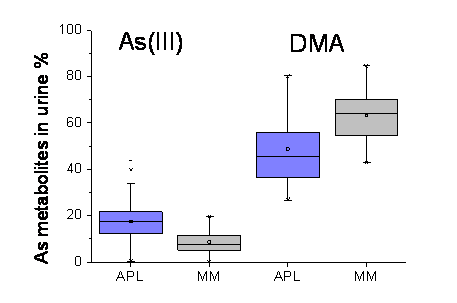Abstract
Introduction
Arsenic trioxide (ATO) has been shown to be effective in the treatment of acute promyelocytic leukemia (APL) and towards multiple myeloma (MM) cells. Biologically active form of ATO is inorganic arsenic in its trivalent form (AsIII) which is metabolised in more or less active metabolites already in hours after infusion. The major arsenic excretion metabolites are methylated, namelly methylarsonic acid (MA) and dimethylarsinic acid (DMA). Despite that ATO already has an established role in APL treatment, there is still a lack of data on its metabolism especially when it is combined with other active compounds. The aim of our study was to get an insight into ATO metabolism through measurement of its metabolites in urine and total arsenic in blood during treatment according two different protocols.
Patients and methods
Patients (8 APL, 12 MM) were treated by ATO (administered as 2 h intravenous infusion) during the years 2004 - 2014. APL patients were previously treated according to a standard APL EORTC protocol. In three patients ATO was started immediately after an interruption of treatment due to a differentiation syndrome and in the remaining five patients ATO was started due to relapse. ATO (0.15 mg/L) was administered for i) 50 consecutive days and prolonged for 25 days (5 days/week) after 3 weeks break or for ii) 25 consecutive days repeated after one week break.
Majority of 12 MM patients was heavily pretreated, relapsed or refractory. ATO (0.25 mg/kg) infusion was followed by injection of ascorbic acid (1g). Melphalan (0.1 mg/kg) or Dexamethasone (40 mg/kg) was added in MAC or DAC scheme respectively. ATO was given in cycles (4 consecutive days followed by 3 weeks of 2 applications/week). Treatment efficacy was evaluated by measurement of a monoclonal spike except for patients with Bence-Jones type of MM who were only clinically evaluated.
The urine samples were taken before ATO infusion and analysed using HPLC separation combined on-line with hydride generation and atomic fluorescence spectrometry. Arsenic species As(III) and As(V) and both methylated metabolites MA and DMA were followed. Total arsenic concentrations in serum were analysed by ICP-MS.
Results
All APL patients have obtained a stable molecular remission. In contrast, efficacy of ATO treatment in MM patients is difficult to be evaluated due to the patients’ initial poor condition. In three MM patients effect of ATO cannot be evaluated since they deceased during the treatment. In four out of 9 remaining MM patients at least a partial remission was obtained.
Differences between both groups, or better between both protocol regimens (consecutive APL or pulse DAC/MAC in MM), are also reflected in As serum levels and in the presence of ATO metabolites in urine. During the therapy the residual As serum levels in APL group were almost two times as big as those in MM group (72,33±16.79 ng/g vs. 45.13±7.2 ng/g). That means that lower daily doses of ATO preserve higher As concentrations in time than pulse therapy with higher doses.
In the urine of MAC/DAC group the proportion of DMA was higher than in the patients treated according APL protocol (48.7 ± 14.6 % vs 63.2 ± 10.4%, Figure 1), while proportions of other three metabolites were lower. A higher proportion of the main active component, As(III), was present in the body of APL patients in comparison to MAC/DAC treated MM patiens (17.5 ± 7.4 % vs 8.6 ± 4.5 %; Figure 1). Differences in metabolites between both groups were statistically significant (MA: P = 0.0127; AsIII, DMA, AsIII: P < 0.0001).
Main active compound (AsIII) and main excretion ATO metabolite (DMA) in urine of APL and MM patients.
Main active compound (AsIII) and main excretion ATO metabolite (DMA) in urine of APL and MM patients.
Conclusions
APL patients receiving ATO daily reached a sort of a steady state with a peak in As(III) concentration after i.v. infusion and gradual fall of As(III) concentration until the next day’s infusion while concentrations of other metabolites remained relatively stable. MM patients received higher ATO doses in pulses so that decrease of As(III) after initial peak ended in prolonged lower As(III) levels in between infusions.
Poor response to ATO treatment in few MM patients can be attributed to their pretreatment status but also to suboptimal treatment protocol. Significantly lower residual serum As levels were observed during DAC/MAC in comparison to daily treatment according to APL protocol. Lower but more frequent doses of ATO, similar to those in APL, may be more effective in MM.
Off Label Use: Arsenic trioxide, drug with known antimyeloma activity. It was used as salvage options in multiple myeloma pts., in whom all other conventional treatment options were exhausted. Those patients would be otherwise treated only in a paliative way. They all wrote informed consent after we discussed the issue with them.
Author notes
Asterisk with author names denotes non-ASH members.


This feature is available to Subscribers Only
Sign In or Create an Account Close Modal